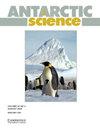麦克默多干谷湖边 "护城河":陆生和水生极地沙漠栖息地之间的生态交叉点
IF 2
4区 地球科学
Q3 ENVIRONMENTAL SCIENCES
引用次数: 0
摘要
水生生态系统--湖泊、池塘和溪流--是南极大陆寒冷干旱环境中生物多样性的热点。预计环境变化将日益改变南极水生生态系统,并改变它们所支持的栖息地的物理特征和相互作用。在这里,我们描述了一个封闭盆地南极湖泊外围 "护城河 "的物理和生物特征。这些护城河是溪流、湖泊和土壤之间连接的媒介。我们强调了护城河从冬季冰冻状态到夏季活跃的开阔水域系统的周期性过渡,以及冬季恢复后的再冰冻过程。夏季融化从湖床开始,最初在 11 月形成受冰限制的液态水透镜,然后迅速向上发展,在 12 月形成开放水域。相反,冰冻从水面缓慢向下发展,湖底 1 米深处的水直到 5 月份仍是液态。护堤支撑着富饶、多样的底栖生物群落,这些群落在分类学上与邻近永久湖冰下的群落截然不同。我们展示了离子比率如何表明夏季护城河、溪流、土壤和冰下湖水之间发生了交换,也许是护城河内部密度驱动的对流促进了这种交换。护城河在湖泊栖息地中占据的面积很小,但却充满活力,受近期湖面上升的影响特别大,因此可能特别容易受到水文变化的影响。本文章由计算机程序翻译,如有差异,请以英文原文为准。
McMurdo Dry Valley lake edge ‘moats’: the ecological intersection between terrestrial and aquatic polar desert habitats
Aquatic ecosystems - lakes, ponds and streams - are hotspots of biodiversity in the cold and arid environment of Continental Antarctica. Environmental change is expected to increasingly alter Antarctic aquatic ecosystems and modify the physical characteristics and interactions within the habitats that they support. Here, we describe physical and biological features of the peripheral ‘moat’ of a closed-basin Antarctic lake. These moats mediate connectivity amongst streams, lake and soils. We highlight the cyclical moat transition from a frozen winter state to an active open-water summer system, through refreeze as winter returns. Summer melting begins at the lakebed, initially creating an ice-constrained lens of liquid water in November, which swiftly progresses upwards, creating open water in December. Conversely, freezing progresses slowly from the water surface downwards, with water at 1 m bottom depth remaining liquid until May. Moats support productive, diverse benthic communities that are taxonomically distinct from those under the adjacent permanent lake ice. We show how ion ratios suggest that summer exchange occurs amongst moats, streams, soils and sub-ice lake water, perhaps facilitated by within-moat density-driven convection. Moats occupy a small but dynamic area of lake habitat, are disproportionately affected by recent lake-level rises and may thus be particularly vulnerable to hydrological change.
求助全文
通过发布文献求助,成功后即可免费获取论文全文。
去求助
来源期刊

Antarctic Science
地学-地球科学综合
CiteScore
3.60
自引率
6.20%
发文量
42
审稿时长
3 months
期刊介绍:
Antarctic Science provides a truly international forum for the broad spread of studies that increasingly characterise scientific research in the Antarctic. Whilst emphasising interdisciplinary work, the journal publishes papers from environmental management to biodiversity, from volcanoes to icebergs, and from oceanography to the upper atmosphere. No other journal covers such a wide range of Antarctic scientific studies. The journal attracts papers from all countries currently undertaking Antarctic research. It publishes both review and data papers with no limits on length, two-page short notes on technical developments and recent discoveries, and book reviews. These, together with an editorial discussing broader aspects of science, provide a rich and varied mixture of items to interest researchers in all areas of science. There are no page charges, or charges for colour, to authors publishing in the Journal. One issue each year is normally devoted to a specific theme or papers from a major meeting.
 求助内容:
求助内容: 应助结果提醒方式:
应助结果提醒方式:


